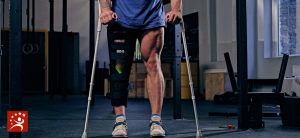The fingers are made up of bones called phalanges. The phalanges in each joint are separated by two joints called interphalangeal joints (IP joint). The two joints are the distal IP joint (DIP joint), meaning further away, and the proximal IP joint (PIP joint), meaning the middle or closer in. These IP joints of the fingers are like hinge joints, allowing us to have mobility with our hands, including straightening and bending.
The tendons allow each of our finger joints to be able to flex and straighten completely. These are called extensor tendons. The extensor tendons come from the muscles that arise from the backside of the bones located in the forearm. These muscles travel toward the hand, where they eventually connect to the extensor tendons before crossing over the back of the wrist joint.
Then, the extensor tendons become what is called the extensor hood. The extensor hood becomes flat in order to cover the top of the finger. The extensor hood sends out branches of ligaments (tough bands of tissue) to connect the bones in the middle and end of the finger. When the extensor muscles contract, they tug on the extensor tendon, allowing the joints to work together, so that the finger can straighten and bend.
Finger position and movement of the hand occur from the balanced actions of many important structures, that work cohesively when everything is normal. Ligaments support the finger joints, muscles hold and give our fingers the ability to move, while tendons help control the motion of each finger. Any injury or condition can disturb the balance and inner workings of all these parts, altering functionality and the alignment and structure of the hand and fingers. The result may be a condition call swan neck.
What is Swan Neck?
Swan neck is a deformity, in simple terms, a crooked finger. The PIP joint (the joint in the middle of the main knuckle and DIP joint), includes the strongest ligament called the volar plate. These ligaments connect on the palm side of the joint. As the ligament tightens when the finger is straight, the PIP joint is protected from bending back too far, or hyperextending. Swan neck deformity occurs when the PIP joint in the finger becomes hyperextended and the DIP joint at the end of the finger is flexed, causing a crooked finger.
Swan neck symptoms include inflammation from injury, or conditions such as Rheumatoid arthritis (RA), causing pain and swelling of the PIP joint. This imbalance causes the finger to look like a swan’s neck, bent and abnormally crooked.
Your doctor will physically examine your finger, and sometimes order an X-ray to check your joints and look at the alignment, to fully diagnosis the problem. Treatment for swan neck deformity can be nonsurgical or surgical, depending upon the severity of the deformity. The approach your doctor chooses will also depend on whether the proximal IP joint is flexible or stiff.
While the term deformity connotes a visual disturbance, remember that it can also affect mobility and day-to-day function, so getting treatment is important! To learn more about swan neck deformity and how to treat it, call the orthopedic surgeons at Colorado Center of Orthopaedic Excellence in Colorado Springs at (719) 623-1050 or request an appointment online.
















